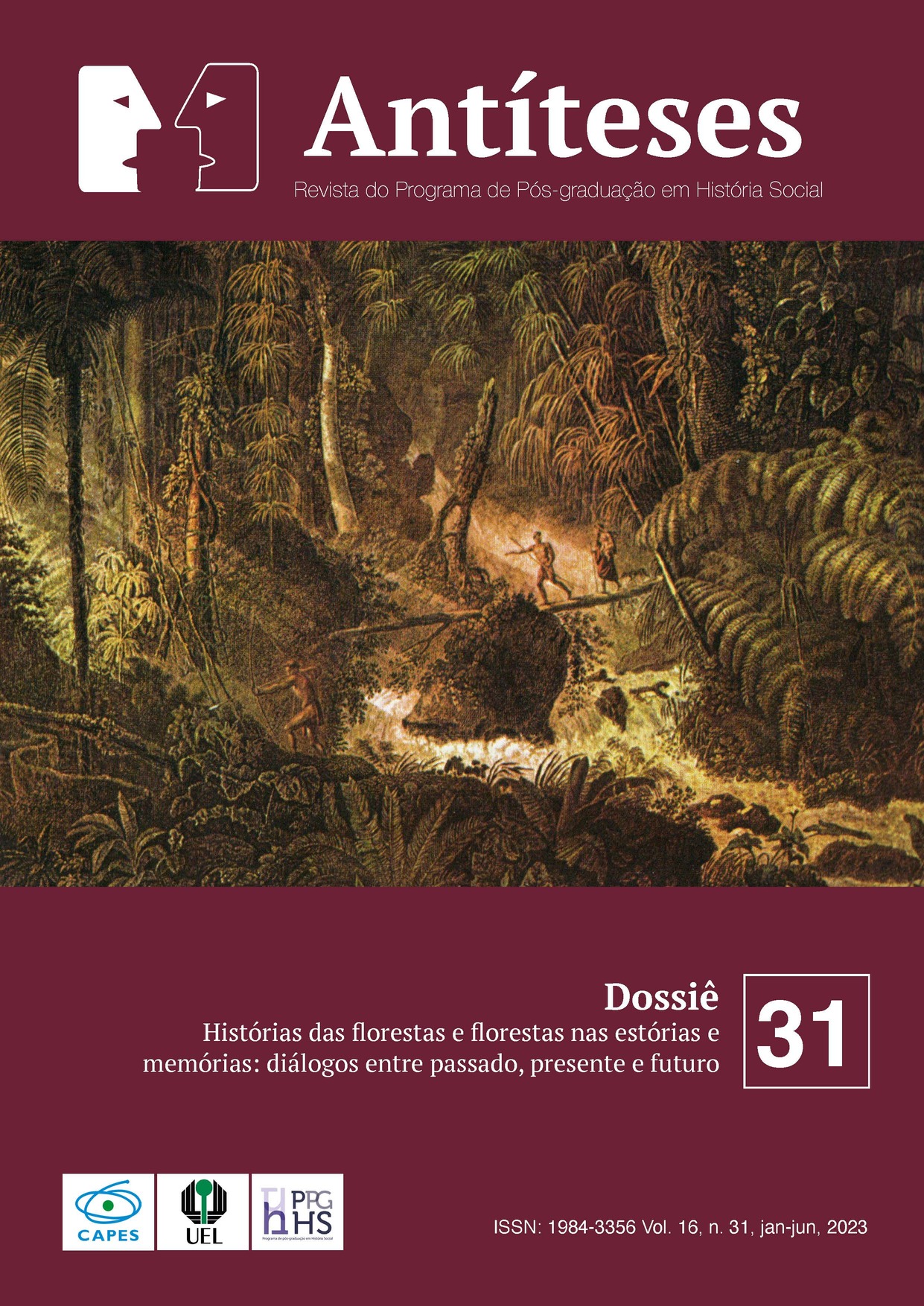“Nenhuma árvore no jardim de Deus era tão bela quanto ele”
turismo religioso e extinção da floresta de cedros do Líbano em relatos de missionários protestantes no Oriente Médio
DOI:
https://doi.org/10.5433/1984-3356.2023v16n31p114-142Palavras-chave:
Cedros do Líbano, História Ambiental, Missionários Protestantes, PeregrinosResumo
Este artigo, na perspectiva da história ambiental, busca demonstrar como o turismo religioso, no século XIX, se tornou um dos fatores que contribuíram para a devastação dos cedros do Monte Líbano e estabelecer a conexão entre o literalismo bíblico e a defesa da preservação da floresta de cedros originários ameaçados de extinção, de acordo com relatos de viajantes e peregrinos daquela época. Por fim, pretende-se responder a seguinte questão: por que algumas passagens bíblicas sobre a natureza da floresta dos cedros no Monte Líbano, local sagrado de peregrinação para os cristãos, foram postas em xeque pela ciência? Para esclarecer essa investigação foram consultados diários de viajantes naturalistas, relatos de missionários protestantes na Síria e a imprensa.
Downloads
Referências
AIELLO, Anthony S.; DOSMANN, Michael S. The quest for the Hardy Cedar-oflebanon. Arnoldia: The Magazine of the Arnold Arboretum, [s. l.], v. 65, n. 1, p. 26-35, 2007. Disponível em: https://arboretum.harvard.edu/stories/the-quest-forthe-hardy-cedar-of-lebanon/. Acesso em: 5 fev. 2023.
ALLON, Henry. Recent travels and explorations in Syria. The British Quarterly Review, New York, v. 57, p. 75-97, July 1873.
ANDRESON, Mary Perle Anderson. The cedars of Lebanon. Torreya, New York, v. 8, n. 12, p. 287-292, Dec. 1908.
AZAIS, Pierre; DOMERGUE, Charles. Journal d’un Voyage en Orient. Avignion: Seguin Ainé, 1858.
BÍBLIA interlinear. Disponível em: https://www.nepe.wab.com.br/interlinear/?livro=13&chapter=14&verse=1. Acesso em: 14 jan. 2023.
BURTON, Richard Francis; DRAKE, Charles F. T. Unexplored Syria. London: Tinsley Brothers, 1872.
BURTAN, Isabel. The inner life of Syria, Palestine, and the Holy Land. London: Kegan Paul, Trench, 1884.
BUSH, George. Illustrations of the Holy Scriptures. Philadelphia: Lippincott, 1856.
CONRADIE, Ernst M. Towards an ecological biblical hermeneutics: a review essay on the Earth Bible project. Scriptura: Journal for Contextual Hermeneutics in Southern Africa, [s. l.], v. 85, n. 1, p. 123-135, 2004. DOI: https://doi.org/10.7833/85-0-941
CARNE, John. Syria, the Holy Land, Asia minor illustrated. London: Fisher, 1836.
CHRIST, Konrad Hermann Heinrich. The cedar of Mount Atlas. Garden and Forest, New York, p. 246-248, May 1890.
CUINET, Vital. Syrie, Liban et Palestine, géographie administrative, statistique, descriptive et raisonnée. Paris: Leroux, 1896.
DALTON, Anne Marie. Ecotheology. In: CASTREE, Noel; HULME, Mike; PROCTOR, James D. Companion to environmental studies. London: Routledge, 2018. p. 271-274. DOI: https://doi.org/10.4324/9781315640051-54
DORON, Bar; KOBI, Cohen-Hattab. A new kind of pilgrimage: the modern tourist pilgrim of Nineteenth Century and Early Twentieth-Century Palestine. Middle Eastern Studies, [s. l.], v. 39, n. 2, p. 131–48, 2002. DOI: https://doi.org/10.1080/714004511
FROLLO, Jean. Le Cèdres du Liban. Le Petit Parisien, Paris, p. 1, 6 janv. 1914.
HARRIS, Thaddeus Mason. The natural History of the Bible. Boston: Wells & Lilly, 1820.
HOOKER, Joseph Dalton. On the Cedars of Lebanon, Taurus, Algeria, and India. The Natural History Review, London, v. 2, n. 5, p. 11-18, Jan. 1862.
HORRELL, David G.; HUNT, Cherryl; SOUTHGATE, Christopher. Appeals to the Bible in ecotheology and environmental ethics: a typology of hermeneutical stances. Studies in Christian Ethics, [s. l.], v. 21, n. 2, p. 219-238, 2008. DOI: https://doi.org/10.1177/0953946808094343
JAENNEL. Du déboisement considéré comme cause de dépopulation et des moyens d'y remédier: Association Francaise pour l'avancement des Sciences Fusionnée avec L'association Scientifique de France. Paris: Au Secrétariat de l'Association, 1891.
JESSUP, Harry H. Fifty-Three Years in Syria. New York: Fleming H. Revell Cia, 1910. v. 1.
JESSUP, Harry H. The natur at the Cedars of Lebanon. El Arz, Beirut, v.1, n. 10, p. 78-79, 1889.
JOURNAL DES DÉBATS, Paris, p. 3, 17 set. 1881,
L’INTRASIGEANT, Paris, p. 2, 4 ago. 1880.
LIPHSHITZ, N., BIGER, G. Cedar of Lebanon ("Cedrus libani") in Israel during Antiquity. Israel Exploration Journal, Jerusalém, v. 41, n. 1/3, p. 167-175, 1991.
MURRE-VAN DEN BERG, H. William McClure Thomson’s the land and the book (1859): pilgrimage and mission in Palestine. MURRE-VAN DEN BERG (ed.), H.L., New Faith in Ancient Lands. Western Missions in the Middle East in the Nineteenth and Early Twentieth Centuries, Studies in Christian Missions 32, Leiden: Brill, 2006, 43- 63. DOI: https://doi.org/10.1163/9789047411406_004
PÁDUA, José Augusto. As bases teóricas da história ambiental. Estudos avançados, São Paulo, v. 24, n. 68, p. 81-101, 2010. DOI: https://doi.org/10.1590/S0103-40142010000100009
PÁDUA, José Augusto. Localizando a História do Antropoceno: o caso do Brasil. In: DANOWSKI, Déborah; VIVEIROS DE CASTRO, Eduardo; SALDANHA, Rafael. (org.). Os mil nomes de Gaia: do Antropoceno à Idade da Terra. Rio de Janeiro: Ed. Machado, 2022a. v. 1, p. 187-217.
PÁDUA, José Augusto. Vivendo no antropoceno: incertezas, riscos e oportunidades. Antropoceno hoje: onde estamos? Rio de Janeiro: Museu do Amanhã, 2022b. Disponível: https://museudoamanha.org.br/livro/10-vivendo-no-antropoceno.html. Acesso em: 14 dez. 2022.
PAXTON, George. Illustrations of scripture, from the Geography, Natural History, and manners and customs of the East. Philadelphia: Hogan, 1822. v. 1.
POST, George E. The botanical geography of Syria. Journal of the Transactions of the Victoria Institute, London, v. 22, n. 88, p. 253-307, 1889.
PORTER, Josias Leslie. Five Years in Damascus. London: John Murray, 1855. v. 1.
RAMOND DE CARBONNIERES, Louis-François. De la végétation sur les montagnes. Annales du Muséum National d’histoire Naturelle, Paris, t. IV, n. XII, p. 395–404, 1804.
TALHOUK, Salma N.; MAKHZOUMI, Jala; MAUNDER, Mike; KHURI, Sawsan. You can't see the wood for the trees: the cedar of Lebanon as a symbol of a country and an ecosystem. Archaeology & history in Lebanon, [s. l.], n. 14, p 114-122, 2001.
THE BUILDING NEWS AND ENGINEERING JOURNAL, [S. l. s. n], 1881.
THE YOUTH'S COMPANION, Boston, 1882.
THOMSON, William McClure. The Land and the Book: Or, Biblical Illustrations Drawn from the Manners and Customs, the Scenes and Scenery, of the Holy Land. New York: Haper & Brothers, 1886. v. 1.
TREW, Christoph Jacob. Christophori Iacobi. Apologia Et Mantissa Observationis De Cedro Libani et Cedrorvm Libani Historiae. Norimbergae: Schwarzkopfius, 1767.
WHITE Jr., Lynn. The historical roots of our ecologic crisis. Science, New Series, [s. l.], v. 155, n. 3767, p. 1203-1207, Mar. 1967. http://www.jstor.org/stable/1720120. Acesso em: 11 jan. 2023. DOI: https://doi.org/10.1126/science.155.3767.1203
WORSTER, Donald. Shrinking the earth: the rise and decline of American abundance. New York: Oxford University Press, 2016.
Downloads
Publicado
Como Citar
Edição
Seção
Licença
Copyright (c) 2023 Marina Haizenreder Ertzogue

Este trabalho está licenciado sob uma licença Creative Commons Attribution 4.0 International License.
A Revista Antíteses adota a Licença Creative Commons Attribution 4.0 International, portanto, os direitos autorais relativos aos artigos publicados são do(s) autor (es), que cedem à Revista Antíteses o direito de exclusividade de primeira publicação.
Sob essa licença é possível: Compartilhar - copiar e redistribuir o material em qualquer suporte ou formato. Adaptar - remixar, transformar, e criar a partir do material, atribuindo o devido crédito.
https://creativecommons.org/licenses/by/4.0/










